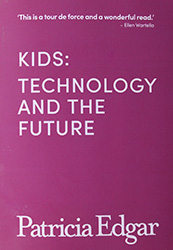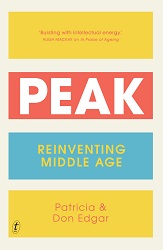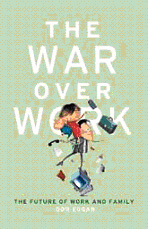
Patricia Edgar & Don Edgar

Does television have a future?
Patricia Edgar, June 2007
“Thirty second commercials are dead. Television is dead. Everybody is dead -- except Google. And itunes. And YouTube”
I have been living in the heart of the digital Mecca of the Western world, the tree-lined, sunny city of Palo Alto adjacent to Stanford University campus; Steven P Jobs, the founder of Apple, jogged past my door. Around the corner stands a landmark, the garage where Bill Hewlett and Dave Packard founded Hewlett-Packard and spawned Silicon Valley. South in neighbouring Mountain View is Googleplex where the famous students who dropped out of Graduate School at Stanford, less than 10 years ago, to create their powerful search engine Googlework to expand their mammoth. Now valued at $126 billion Google is transforming access to information in a revolution as profound as that prompted by Gutenberg's printing press. Just north, in Menlo Park, you can find the room rented by two young guys who started business in an office above a pizzeria and created YouTube. Yahoo too was spawned by Stanford graduate students. Stanford University and its computer science department - now housed in a building paid for and named after Bill Gates - has been the engine that ushered in the internet era.
Every day the newspapers carry articles about the frenzied business of new technology. Private equity companies are getting into the game, as the tech companies are credited with a new level of maturity, investing $109.9 billion by June 2007. The battle between television and online media giants for market dominance is intense; there is both excitement and desperation as companies compete to solve challenges that will make or break them.
No one appears to know where the technology and content industries are headed and what will be the effect of this technical revolution on traditional media. The television networks are scrambling to retain audiences and seek viewer loyalty among the 'affluencers' - the affluent, influential and engaged young viewers who are avid consumers of new technology and whose buying decisions are influencing the future of programming.
Apple is competing on all fronts, redefining the industry, and challenging its archrival Microsoft with the release of a Windows browser. Dubbed “the Jesus Phone”, “the most out-look-changing piece of electronics to come along in years” (NYT, June 27,2007), Apple's new iphone - phone, cum web browser and music player, released on June 29th, aims to bridge the worlds of technology and entertainment. Mr Jobs claims it is 5 years ahead of the hand-set industry; video rentals are the next target. Apple TV has arrived in stores, joining the Mac, the iPodand the iPhone as one of four key businesses. “I'm a Mac” computers with the new Leopard operating system will be released later in the year. Apple and Microsoft have been moving to challenge television by enhancing desktops with software packages like Front Row or Media Centre which display videos and play music with a simplified interface. PCs are disadvantaged in the family room because they can take a long time to start, blow noise and are susceptible to viruses. Consumers demand more and care less about how they get it.
Sergey Brin and Larry Page, the brilliant inventors of Google Inc. with its corporate motto - “Don't Be Evil”- are being viewed more as predators than renaissance men as Google competes with all comers. The young students began with a vision, not the desire to make money. They held venture capitalists at bay so they would not lose control of their company and had a deep aversion to advertising, fearing it would corrupt search results. But in the end success is built on growth; growth requires money and investors require a business model and a CEO. Google's hypergrowth, fueled by a partnership in advertising has led a revolution, as companies shift billions of dollars of their ad spending from television, radio, newspapers and magazines onto the Internet. The nature of advertising and the marketing of goods and services is changing. As the industry leader in information retrieval and the information access point on most issues, Google's evolution is being increasingly viewed with suspicion.
The company's entry into China is seen as cynical profiteering, despiteclaims Google will reform from within. Once relatively indifferent to government affairs, Google Inc is seeking help from Washington to fight the rise of Web censorship worldwide. They argue Internet restrictions are international trade barriers like tariffs. Government censorship is a potential threat to Google'sadvertising-driven business model.
Google's shift in business philosophy was evident in its recent tiff with EBay, one of Google's largest clients. EBay has taken its online advertising elsewhere after Google attempted to capture EBay's 9000 buyers and sellers with a free party to promote Google's Checkout online payment service. Google cancelled the party. Google has a controversial new service, Street View, which reveals 360 degree photographs of neighbourhoods and captures what goes on behind open windows. Google's power, its broad reach, and its tactics are sounding alarm bells and Mary Anne Ostrom (San Jose Mercury News, June 10, 2007) reports suggestions the company is attempting to become the 51st State and change the definition of mainstream, as presidential candidates post videos on YouTube and buy ads on Google.
Privacy groups are calling on the Federal Trade Commission (FTC) to review the recent transactions proposed by Google to acquire DoubleClick , and Microsoft toacquire aQuantive, and for the FTC to set long overdue industry standards for consumer privacy on the Internet. ( San Jose Mercury News, June 7, 2007). Googleis responding by expanding its lobbying efforts in Washington to help win the approval of its DoubleClick deal. And Google deputy general counsel has gone public to put the lie to criticisms of Google's privacy policy and calm the phenomenon of “Goolephobia”(San Jose Mercury News 17/6/07). In Australia the ACCC hit Google with a law suit, July 12, alleging misleading and deceptive conduct and breaches of the Trade Practices Act over sponsored links on the Google website. This case could be an international landmark.
Both Google and Microsoft have their sights set on the mobile Web, but carriers will do all they can to limit their access to new revenues through their infrastructure. The AT&T ( Apple's iPhone partner) is the largest phone company in the US, as well as the biggest wireless carrier. CEO Edward Whittacre says of the search companies, “They don't have any fiber out there. They don't have any wires. They don't have anything. They use my lines for free -and that's bull”. ( San Jose Mercury News, June 6).
Technology is changing faster than fashion. YouTubedid not exist two years ago. In October 2006 Google paid $1.65 billion to buy the 20-month-old website. Rupert Murdoch and his News Corp then acquired My Space for $580 million. Today the television networks, and the media companies that own them, define themselves not as programmers, but as content providers.
“Thirty second commercials are dead. Television is dead. Everybody is dead -- except Google. And iTunes. And YouTube”, pronounced Gary Carter, the president of Creative Networks atFremantleMedia, the company that dreamed up Pop Idol in the UK, which became American Idol, and Australian Idol, a franchise described by San Francisco Magazine, (June 2007)
as the definitive blockbuster hit on American television in the 21st Century.
This is a valley where you don't wonder if the world is about to change drastically. It already has.
'Television Executives, in search of the next new hit, are as desperate as the housewives on Wisteria Lane”.
The commercial television networks finally understand they must work hard to stay on top and see their salvation - as they have always done - in new program ideas. In this environment, network executives in search of the next new hit, are as desperate as the housewives on Wisteria Lane. They know the business model they have relied on for decades - a single revenue stream based entirely on advertising - is obsolete. The major TV Networks were the reliable place to go for advertisers seeking broad audiences, but the mass audience is now fragmenting. Ratings still rule and new revenue streams must be found, so when new programs fail production heads roll; the turnover among television executives is high.
Following two decades of mergers, the massive media companies Viacom(NBC), Time- Warner (CBS), Disney(ABC) and News Corp (FOX) have found size alone is not the answer. Adding a movie studio, a big television production arm and a well-stocked library of intellectual content to a Network has not been enough, and at midnight on February 7th 2009 they face a major upheaval: analogue airways in the United States will cease to signal local television and programming will be transmitted exclusively over the digital spectrum. Australia will follow in 2010-12.
The networks are gambling that one thing will not change, no matter how television is to be viewed - on computer monitors, on cell-phones, or on massive TV screens: people will always want to see hit shows. In this conviction they rely on history. A network can rise from the ashes with one hit. Desperate Housewives, which has attracted more than 21 million viewers - the most watched new show on ABC Network in a decade and a hit in every English speaking country in the world - proved this, as did Lost, which drew 18 million viewers and became a phenomenon from its first week on the air. American Idol took Fox to the position of top rating network.
Finding these shows requires imaginative production executives who are bold decision makers. Such attributes are rare within network television structures; where so much is at stake, risk-taking can be terminal. When break-out shows arrive, it is usually as a result of a whim, incredible luck and the courage and fortitude of a daring producer. Hits which will keep the networks viable are not easy to come by.
Bill Carter, author of Desperate Networks(2006), outlines the hazardous route taken by Marc Cherry the creator and producer, who endured repeated rejection and a life of poverty and despair to get Desperate Housewives on air. Lloyd Braun, the Network executive who believed in and shepherded Lost through the ABC, overcame doubts, resistance, disrespect and termination before he was vindicated. These two shows alone saved the bacon of two Networks and launched Network 7's revival in Australia.
The UK's Pop Idol was picked up by Fox on the order of Rupert Murdoch who overruled his uninterested executives. Murdoch insisted the format remain true to the UK original which meant Simon Cowell, the abrasive judge from the UK show, was paid $36 million for 90 minutes of work a week - thought to be the highest paid performer per minute on network television - to secure his services. The investment was considered justified when American Idol returned astonishing ratings - 33.5 million viewers.
Television remains the advertising flagship with US$65.4 billion going to the Networks in 2006, but advertisers are beginning to spread their assets around, with more money going to on-line media, and they are asking the Networks difficult questions.
As a result, network programming is changing; networks are learning to let go of beloved series they have run into the ground. Sit-Coms like Friends, Seinfeld, Cheers, once the staple of American network television, are hard to find as new ideas fail.
Family television, where the entire family gathers together around the television on a Saturday night, has gone. Such viewing seems alien to kids now, many of whom have their own televisions, computers and iPods. By age six 33% of children have televisions in their bedrooms and 23% have VCRs (The Media Family: Electronic Media in the lives of infants, toddlers, preschoolers and their parents, The Henry J Kaiser Family Foundation Report, Victoria Rideout, Elizabeth Hamel, May 2006).
While many Americans claim to want a refuge from the sex and violence of TV, and major sponsors including Proctor and Gamble and FedEx have funded The Family Friendly Programming Forum (which underwrites script development, programs and scholarships for students interested in producing family entertainment), shows seeded by the Forum, including Commander in Chief, failed to maintain ratings. Whereas once, multi-generational dramas, such as The Walton's or Eight is Enough, would hold the family audience, today, if families sit down together to view television, it will be to watch American Idol.
Game shows remain popular; serialised dramas are few, with Heroes an exception. British shows are in, following the spectacular success of American Idol and The Office. Once ignored as a program source, Britain is being monitored for new ideas.
Reality shows dominate the schedules and the ratings; they are cheap to make and if they fail the network hasn't invested heavily. What they lose increasingly is respect. The most degrading example of a tacky grab for ratings this season was The Bachelor, with Mark Philippoussis as a vacuous beefcake - claiming to be searching for the love of his life - encouraging women over 40 years, “the cougars', to compete with 20 year olds ,'the kittens', for his affection.
Looking at television, facing a technical upheaval, there is little evidence of innovation in programming ideas. Networks continue to draw on the past for ideas to reinvent.
The annual TV “upfronts”, when the top network executives present their program line-ups (along with an argument that they know what viewers they will attract) to dubious Madison Avenue advertisers, was held in May.
Mr Murdoch's Fox Network is number one among young viewers (those whomadvertisers covet) but its success is built almost entirely on the popularity of two series - American Idol and House. Their new line up will include four new dramas, three new comedies and three new reality shows including The Search for the Next Great American Band and Nashville, a docu-soap which follows a group of young hopefuls trying to make it in country music.
NBC, which is in a rating's slump, is betting on science fiction, fantasy and escapism to attract viewers along with a spin-off from Heroes - their hit from last season - called Heroes: Origins, and a revisionist version of Bionic Woman (a series from the 70s).
ABC, already home to the biggest drama hits will spin off Grey's Anatomy with Private Practice. In the spirit of Desperate Housewives ABC has another new drama Dirty Sexy Money, in which Peter Krause ( Six Feet Under) plays a lawyer for an absurdly wealthy, venal, corrupt family. Cashmere Mafia is yet another series attempting to replicate the successful formula of Sex and the City with a group of New York women in and out of romance.
CBS is exploring film noir and themes like vampires, swingers and singing casino workers. Viva Laughlin, (based on a quirky, dark, UK show Viva Blackpool), stars Hugh Jackman: characters lip-sync contemporary songs in the style of the British series Pennies from Heaven. Swingtown is a serial drama set in the 1970s which centres on a couple who move into suburban Chicago and learn, to their shock and fascination, that most of their neighbours are into the swinging culture.
There will be a new CBS game show, The Power of 10 where contestants guess answers to questions about the social behaviour of Americans and lifestyle trends, for the ultimate prize of $10 million. (Who wants to be a Millionaire? has had its day) Kid Nation is a new reality show which involves a group of 40 kids (aged eight to 15) who have 40 days to build a new society with no adult supervision - a Lord of the Flies type situation.
There is nothing revolutionary here.
The real content revolution is taking place in advertising.
The scrambling for new programming ideas is taking place amid growing awareness that people are watching television differently. The traditional system of measuring TV ratings counts only those viewers watching the live broadcast; those who record and watch online are lost to the networks who then cannot charge advertisers as much for commercials. Revising the traditional system of measuring TV ratings of programs is gaining urgency because an estimated 17% of American households now own DVRs. In some cities DVR penetration exceeds 25%. Several popular shows, like Grey's Anatomy, The Office and 24 are being watched, increasingly, as recordings, not when they go to air. To deal with this new phenomenon Neilson Media Research, the ratings arbiter, has agreed to count viewers who watch the show live or within 72 hours of a program's original appearance in a formula called “live plus three”. The networks are pushing for a “live plus seven” standard.
While the search for ideas remains desperate, (with most series failing in their first season, often in their first weeks), the threat posed to the Networks by the changing face of advertising and the potential loss of their revenue base is terrifying executives. The online advertising sector has grown wildly in the past 10 years, increasing from $907 million in 1997 when it accounted for less than one per cent of all advertising. Now interactive ads represent 5.9% of the $286 billion spent last year by advertisers. As a sign of the times online ad spending increased 17% last year to $9.8 billion as opposed to only five per cent growth for television according to Jaimal Yogis, (San Francisco Magazine, June 2007)
TiVo, podcasting, broadband television, and even the simple remote control, mean viewers no longer have to watch the ads if they don't want to and more and more people don't. In its first quarterly profit this year digital video recorder pioneer TiVo has posted a small net profit.
2006 was a pivotal year: down-loading had taken off and the networks began to face the reality born of an explosion in technology. In response, Disney made deals to sell episodes of Desperate Housewives on a video iPod, NBC made deals with iTunes for downloads, CBS made deals with Comcast for video on demand. The networks challenged the cable industry, which draws revenue from both advertising and subscription, with the demand they pay a subscription fee for network programs- no longer would retransmission be free.
Virtually every bit of programming the networks come up with is now designed for initial use on a television set and then the digital world. It is no longer enough to have the best or most popular show on during the prime-time hours every night; it is essential that viewers be given opportunities to locate the shows they want to watch at any time.
At the 'upfronts' the five networks announced experimental plans to hold viewers' attention during commercials. They are inserting games, quizzes and mini dramas into breaks. Products are being integrated into plots for the show; two experimental programs without traditional commercial breaks will premiere in the US this fall.
NBC announced several formats including creating a single commercial that lasts for an entire break and developing story-lines that run through the ads. To enhance their pitch, they enlisted the presence of Jerry Seinfeld who is to feature in short video clips to promote his animated film, Bee Movie, during programming.
The most frequent experiment is to insert original content into commercial breaks and use network stars to pitch ads, as seen on Desperate Housewives and Ugly Betty. Fox created an animated taxi driver, Oleg, to appear in breaks talking to his passengers. He has gained quite a following. Court TV offered a news story about an unsolved murder with clues dropped in commercial breaks online and via text messages. The game's winner won $25,000 which gave incentive to watch. Fans of NBC's Scrubs were asked trivia questions at the beginning of a commercial break with the answer appearing between ads. Real ads are being played on television sets in the show and there are experiments with “cwickies”, 5 second ads that come together in a longer ad by evening's end.
All this creativity aims to stop viewers with digital video recorders from fast forwarding through advertisements. The Nielsen Media Research Company is offering ratings for commercial breaks instead of just the shows around them. Nielsen estimates that in prime time nearly half the 18 to 49 year old viewers are watching recorded programs and of these, six in 10 skip through the ads. This means a lot of missed opportunities for marketers.
With such a volatile marketplace, the traditional advertising agency is changing. Publishers are creating their own in-house ad agencies planning alternative ways to create contagion, ways which don't involve television. The new advertising landscapes include YouTube videos you watch on your cell, Bluetooth billboards that flash you private messages, and online fantasy worlds you wander in for hours. Smart agencies are creating ads online that people actually seek out for fun, then pass on to friends: the 'stealth, viral ad' is a branded Internet film like a TV commercial, but without the 30 second time limit. They spread via e-mail, blogs, and word of mouth. The 'webisode' is a short sitcom with a branded message. The 'consumer generated commercial' is an ad made by the people for the people.
There are long-form interactive, viral campaigns that draw viewers in for weeks at a time. The 'mashup' is a branded site that lets consumers mix and match multiple digital media -video music, animation - often for a contest. There are helpful online service websites (called “free services”) with video board updates from cheap, sponsored, winter sporting events, and music tracks to download from artists. Jeep Uncharted is the best example. 'The addictive time suck' is the name given to interactive games, quizzes, and 'pass-it-on tricks' that are irresistible - even when you don't like the brand they are promoting. A Budweiser site lets you craft apologies to girlfriends, boyfriends and relatives and have a robotic voice delivered them via cellphone.
On-line's growth is inexorable, an advertising gold mine to be tapped
When television began no one could have envisioned the thousands of satellite channels and DVDs that would some day emerge as viewing options. Similarly no one is sure of the ways by which the Internet will change our lives and where online advertising is headed. The YouTube and MySpace fans are angry at ad agencies for co-opting the Internet's democratizing space to shill for the big companies. Eventually, these new agencies say brands will be at the forefront of total digital integration, the merging of your mobile phone, your computer screen, your TV, and the world outside.
Every thing old is new again. Stuart Elliott (The New York Times, 13/6/07) pointed out that 'branded entertainment', which is new to contemporary advertisers, was a mainstay of marketing from the 30s through to the 60s. Back then sponsors were featured in the title, like the Bell Telephone Hour or Lux Radio Theatre. It faded because it became too expensive for individual sponsors to finance full production of a series. And questions arose over undue manipulation of quiz shows at the behest of advertisers, a lesson that should not be forgotten.
A coming series Mad Men (which ironically, is about the advertising industry and those who chose it as a career, circa 1960), will feature Jack Daniel's Tennessee Whiskey on and off the show. Just as cigarettes became embedded in popular movies of the 40's and 50's, Jack Daniel's will be embedded in every aspect of the series. Characters will drink the whiskey in various scenes or ask for the brand by name, sets will be decorated with vintage bottles, decanters and ads. Executives associated with advertising and public relations campaigns for Jack Daniels will be among the industry figures interviewed for short segments about 'ad legends' past and present. And Jack Daniels will be featured in promotions asking viewers to watch the series, as well as in brief vignettes to introduce commercials that the network is calling “mad advertising”. Off the show, Jack Daniel's will be the sponsor of the “Mad Men” section of the AMC cable Web site and will be credited on posters, print ads and other materials intended to encourage viewers to tune in.
Despite such efforts television is dragging its feet as the online industry embraces the opportunities presented by advertising.
In the old days of the dot-com era online ads were simple billboards on a website placed in the hope that visitors would notice them. The process of delivering relevant, search-based ads- Google's bread and butter- is comparatively easy. A typed search term sets off related text ads which appear next to the results, exposing consumers to sundry generally relevant advertisers. But faster and cheaper computing and sophisticated software algorithms are making advertising more intelligent and measurable. Quants have become a force in the advertising industry. Online's growth is inexorable, an advertising gold mine to be tapped and Googleis a front-runner. Searching accounts for only about 5% of the time people spend online; the other 95% is spent on the wider Web where a different advertising landscape looms. There is the Internet's equivalent of glossy magazine ads or television commercials, typically the province of brand advertisers like Nike and BMW. This is the next big online opportunity where advertising can reach specific audiences in ways not seen before.
The goal, according to Steve Lohr (New York Times, May 16) is to refine the process to deliver select audiences, of thousands, even millions to mass marketers through behavioral targeting, social networking algorithms, predictive economics and other mathematical strategies, trying to work out which ads work, with the idea of advertising only to prime customers.
Behaviorial targeting tracks, analyses and predicts online behaviour based on where you have gone before on the Internet. So if you recently visited sports and auto Web sites, and read global warming articles on news sites, you would mostly most likely turn out to be an 18- to 45-year-old male. An algorithm would then determine that you would be a good candidate for an ad about Toyota's hybrid-electric Prius. If you have clicked on a few banner ads about dieting or purchased a book about carbohydrates you will be considered a good target for diet products. Advertisers are willing to pay high rates to reach such screened audiences.
With online advertising's growth accelerating, the four giants of the web have invested more than $10 billion in two months (April/ May) to buy businesses that control how ads are bought, sold and displayed across the Internet. Google paid $3.1 million for DoubleClick which specializes in software for display ads. Microsoft announced it would acquire Seattle online advertising and marketing firm aQuantive for $6 million. Yahoo recently bought the 80% of Right Media that it did not already own, for $680 million.
The sites that draw the most traffic - Google, Yahoo, Microsoft's MSN and AOL - are now competing, not just for traffic to their own home pages, but for the advertising they display on behalf of other sites. These large Internet companies want to become intermediaries connecting advertisers to the millions of Web sites that have fragmented the online audience with their online video games, cell-phones and Internet television services. There are scores of small innovative companies that are behind this revolution on Madison Avenue.
According to Miguel Helft, ( New York Times, May 19) these recent deals are “blurring the lines between the big Internet companies and traditional advertising companies like the Omnicom Group, WPP Group and Publicis Groupe, potentially bringing them into conflict” Goodby, Silverstein & Partners, a leading advertising agency based in the San Francisco Bay area predict brands will become the new networks, making advertising agencies more like Hollywood producers and branded entertainment just one of many options.
TV is playing catch up.
The fear that these new partnerships will accelerate the migration of brand advertisers and diminish their revenues has prompted television Networks to diversify in an attempt to catch up. The first big deal to be announced following the “upfronts' (New York Times , June 14) is between the NBC Universal division of the General Electric Company and the Media Agencies of the WPP Group. The agreement is valued in excess of $800 million and includes NBC, Telemundo and Broadcast TV networks, as well as cable networks Bravo, Sci-Fi and USA. It includes all parts of the television schedule - daytime, late-night and news programs, in addition to prime time - along with digital operations like nbc.com as well as branded entertainment elements integrating products into the plots of the shows. Every opportunity to profile products will be taken.
NBC is developing a Web Site for students called iCue(IQ), intended to engage teachers and students and woo a generation of potential viewers to NBC News (which will be delivered on electronic devices from laptops to cell-phones). NBC's Bravo channel has ambitious plans to cash in on its shows including Top Chef, Shear Genius, Top Design and The Real Housewives of Orange County with branded books and licensed merchandise ranging from cutlery to gym clothes. Bravo Media has forged an alliance with a talent management company to oversee the careers of chefs, hairstyles, designers and others who compete on its reality contest shows, as well as ordinary people who become stars in docudramas such as Work Out. No opportunity will be missed.
As broad-band penetration increases, making it easier to watch video clips online, online video is becoming a significant advertising medium. TV series are being shortened to five minutes for viewing on a PC. This is one way for My Space, (the social networking Web now owned by News Corp), to generate revenue. Honda will be the sole sponsor of what Sony Pictures television is calling the Minisode Network launched in June. Visitors to the website are able to watch episodes of 15 Vintage Sony series, including Charlie's Angels, TheFacts of Life, FantasyIsland and Who's the Boss? edited from their original 30-60 minutes. Honda will run a two second commercial appearing before the shortened episode starts. Eventually these minisodes will be available on cell-phones.
Indeed cell-phones are seen by some as the future. Forrester Research reported (New York Times, June 17, 2007) cell-phones rank higher than television in the 18-26 age group and media executives are hoping it will have a large appetite for mobile video content. When asked which device they felt they could not live without, 38% of this age group said they could not do without their computer and 28 % said they could not do without their cell-phone.( This is the group that lined up to buy Apple's iPhone). Only 18 % mentioned television first. Young dexterous fingers, combined with good eyesight make cell-phones the technology of the young; the Baby Boomers prefer their television on bigger and bigger screens but they are not the main audience the advertisers seek.
The media companies' response to such data is to make plans to transmit full hour episodes of shows like Lost and Grey's Anatomy on cell-phones. Whether the demand will be there to view programming on a mobile device with a tiny screen is yet to be seen but some are banking on it. ESPN - the sporting channel - is confident this is what viewers will want. A CBS viewer survey learned 64% of 18-24 year olds watch television with their cell phones nearby. CBS sees the cell-phone as the substitute when viewers are not near their TV sets and before long, as people are more mobile, they will want mobile content.
New media are providing the means for the media savvy generation to experience what they want most out of media, while avoiding mainstream television.
This is a new media dawn, and this is television in the competitive world of the Internet and the mobile Web. But there are dangers for the Networks. Advertisements now take up 16 minutes per hour on network TV. It is a most frustrating and irritating experience watching American television with its barrage of interruptions. Much is execrable and Americans have had enough. In a 2006 poll by Interpret LLC, 56% of Americans said they would fast forward through every television commercial if they could.
So network advertising is going to have to be extremely clever to capture an audience for whom content may just not be king. Yahoo CEO Terry Semel lost his job in June, asunder his leadership Yahoo focused on partnerships with Hollywood, believing content was the key to success. Its rival Googlefocused on technology and pulled way ahead; it was the search engineering that proved more attractive to advertisers.
We are told repeatedly that media is a conduit; television, radio or web sites simply deliver content in some form. But increasingly content is itself becoming a medium; one for interaction and a means of connecting with others. The young generation is the connected generation; media is their social currency. Their use of cell-phones and SMS, iPods and the Web has driven new and unanticipated developments in communication. They are harder to track, they are media savvy, and they are cynical about advertising. Increasingly they are making lifestyle choices that are environmentally friendly; they are changing the ways they consume.
As marketers revive branded entertainment and bury products within the content of television shows to blur the line between advertising and programming, they take a risk. They are up against the most media literate consumers in history who are cynical about marketing ploys, place a premium on transparency and are unlikely to take kindly to seeing characters spruiking products in the middle of their programs. Programmers and advertisers must move fast, and think smart to attract the young but they will not succeed unless they understand the new culture in which they are working.
Google epitomizes this culture in so many ways. Its young inventors are exploring the production of affordable, clean-burning fuel; wireless access around the world; googling your genes. Bill Gates has stepped down and Sergey and Larry are the new generation dreaming dreams my generation could never have contemplated. They have stepped into Microsoft's shoes as the power that needs to be fettered charged with confusing advertising with information content online. But that is exactly what television is doing increasingly to salvage its content business.
In Silicon Valley young software developers eat, drink and talk code at advertised 12 hour programming parties (open to the public) every six weeks or so. Dozens of people attend these informal gatherings dubbed DevHouse. The organizers say they are trying to resurrect the spirit of “the Homebrew Computer Club,” the legendary 70's garage gathering of Steve Jobs, Steve Wosniak and other founders of computer companies. (San Jose Mercury 17/6/07) They are reaching out to like minded others to communicate in a changing world.
New York media ecologist, Douglas Rushkoff (Get Back in the Box, Collins 2005) says, “The best reason people purchase stuff in a networked culture… is to share it with other people... The many forms of content we collect and experience online - from images and videos to music files and clever opinion pieces… are excuses to send an e-mail, or something to have when the conversation goes quiet at work…People will share anything they've got …in order to make contact with others.” Rushkoff believes the every-man-for-himself ethic of consumerism is giving way to a desire for community and connectedness, particularly in the face of drought, global warming and evidence of our need to live together. In evidence he cites the number of college students volunteering since 9/11, which has grown by more than 20%.
New programs on network television infused and surrounded by selling pitches are not the main game in this culture. People want more. In this interconnected world there is some evidence that the generation we as parents have worried about, because of their immersion in media, may be the ones to outsmart the media.
In the changing media culture there is a chicken and egg problem for television to resolve. The medium requires a lot of money to produce its hits. Even with diversification into all forms of content transmission, they rely on selling products for their revenue. Advertising is intrusive and annoying and the more of it that is inflicted on consumers, the audience wants and will find ways to avoid its impact. New media are providing the means for the media savvy generation to experience what they want most, out of media, while avoiding mainstream television. As digital television will fragment media more, why would the young generation return to the big screen?
The moments when television captures the attention and imagination of its audience are very few. With drama, the final episode of The Sopranos was one such moment. A nation talked about what would happen and what did happen on the front pages of the press around the US. There was passion, anger and delight, and the creative choices the writer made were national news and domestic and workplace conversation for days after the final episode aired. Can you imagine the effect on a creative writer when ordered to script a character like Tony Soprano with a line to his wife like: “Carmela I'll put on my Nikes, go pick up my New Jersey Times, take my Toyota Prius and meet AJ at McDonalds”.
Television rarely offers the best of what it is capable. But it is a medium that demands risks be taken if the fleeing viewers are to be recaptured. If chopping up and recycling content along with rampant commercialism are the best solutions television executives can come up with, the medium will die.
In Australia we work in a time warp, waiting for the Networks in the US to take the risks with programming and advertising that will sort out our own media fate. Our television networks have announced the US programs they have snared following the 'upfronts' (The Australian July 2nd) - programs they can buy more cheaply than making their own. This approach has worked in the past but now carries bigger risks. The US networks beat the bushes for ideas to solve their problems, there has never been a time when the creation of a successful program stood more chance of adaptation in the US. But embracing change has not been the way the television industry has worked in Australia. Nor do we find innovation in the production industry in Australia with its bureaucratic processes and copycat programming. TiVo, the on-demand digital television recording pioneer, and Australian broadcaster Seven Media Group, plan to bring the service to Australia and New Zealand starting next year. Australians, we can be sure, will work to avoid the ads as Americans do. And the media companies will try to trick consumers into watching advertisements in any way they can.
Ours is a world different from one ever known or imagined before. Darwin's evolutionary theory demonstrated you adapt or you die. Newspaper revenues are plummeting as readers flock to the Internet for information, advertisers head to Craig's list (an online community that began in 1994 as a simple listing of local events by a San Franciscan, Craig Newman, to about 20 of his friends and now serves more than 120 cities) because Craig does not believe everything has to be about money and people trust Craig more than the classifieds. The television audience is down. (The Director of research at Australia's biggest media agency Mitchell and Partners confirms the same pattern of viewer loss to television is occurring in Australia as in the US. The number of 25-54 year olds watching prime time commercial television has slumped 16% since 2002). YouTube page views are up. People have stopped buying CDs in favour of downloading on iTunes. There is growing scorn for the mass media that lionizes and demonizes Paris Hilton, Lindsey Lohan and Britney Spears and for journalists who helped decide to bomb Iraq.
Networks are grasping for a way to grow profits in the Internet age and satisfy advertisers' needs. Advertising is predicted to remain strong but is increasingly seen as manipulative, dishonest and a ubiquitous irritant; the business needs to market itself much more effectively than it does. And in a country where three of the Republican presidential candidates have stated they don't believe in evolution, and half the country believes in 'intelligent design', creative adaptation to technological change is slow. There is an assumption in Middle America that television will go on in much the way it always has. In Australia we are more interested in the ratings battle between Networks 7 and 9, than what will happen to television when the Baby Boomers have moved on and the young media savvy generation is the mainstream.
While Silicon Valley cannot be said to represent the US, its residents are determining the changes that will affect us all. As a result television, along with those media companies which are unable to embrace innovation and adapt fast enough to contribute to this technological revolution, serving the needs of consumers rather than exploiting them, will go the way of the dinosaurs.









